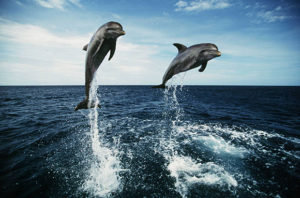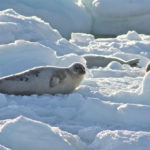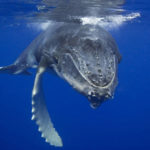Dolphins
 Dolphins are not fish at all, as many believe, but water mammals of small size that belong to the Cetaceans. Dolphins are in direct relationship to whales and killer whales (the latter are actually large dolphins). Very distant relatives of dolphins can be considered pinnipeds and terrestrial predators, leading a water way of life (sea otters). This group of animals is extensive and diverse and has 50 species.
Dolphins are not fish at all, as many believe, but water mammals of small size that belong to the Cetaceans. Dolphins are in direct relationship to whales and killer whales (the latter are actually large dolphins). Very distant relatives of dolphins can be considered pinnipeds and terrestrial predators, leading a water way of life (sea otters). This group of animals is extensive and diverse and has 50 species.
Common features of all types of dolphins are a bare, streamlined body, flexible and muscular at the same time, strongly modified limbs that have turned into fins, a small head with pointed snout and a dorsal fin that most dolphins have. On the head of these animals, the transition between the frontal part and the nose is well pronounced. The eyes are small and they see dolphins badly, because they do not use eyesight to track down prey. They also lack tactile vibrations and sense of smell. Nose as such in our understanding, dolphins do not. The fact is that dolphins are so adapted to permanent habitation in the water that their nostrils have merged into one breathing hole (respiratory), which is located on … the parietal part of the head. This allows animals to breathe when their body is submerged almost completely.
In addition to the nose, dolphins also lack ears. But they have a rumor, but it acts in an unusual way. In the absence of external auditory holes, the perception of sounds was assumed by the inner ear and air cushions in the frontal part of the brain, which act as a resonator. These animals have perfect echolocation! They capture the reflected sound wave and thus determine the location of the object. By the nature of sound waves, dolphins also determine the distance to the object and its nature (density, structure, material from which it is made). Without exaggeration, we can say that dolphins literally see the world around them through sounds and see it much better than other creatures!
The dolphins themselves make sounds similar to crackling, clicks, clinking and even chirping. The sounds produced by dolphins are extremely diverse and complex, they consist of many separate modulations and are used by animals not only for communication, but also for communication with the surrounding world. The teeth of the dolphins are numerous (40-60 pieces), small and homogeneous. This structure of the dental system is due to the fact that dolphins only catch prey, but do not chew it. The body of dolphins is completely naked, devoid of even the smallest rudiments of wool. Moreover, the skin of these animals has a special structure, which reduces the friction of water and improves the hydrodynamic properties of the body.
Since dolphins are very mobile and constantly move in water at high speeds, the outer layer of the skin is constantly deteriorating. Therefore, deep layers of skin have a powerful reserve of regenerating cells, which are constantly divided. For a day, the dolphin is replaced by 25 cell layers of skin! We can say that these animals are in a state of continuous molting. Coloring in dolphins can be of two types: monochromatic (gray, black, pink) and contrasting, when large areas of the body are painted black and white.
Dolphins dwell exclusively in water bodies, never leaving the water column. The range of these animals is very extensive and covers almost the entire globe. Dolphins are not present only in the coldest arctic and subantarctic waters. Most of these mammals live in salt waters – seas and oceans, but some species of dolphins (Chinese and Amazonian river dolphins) live in large rivers. Dolphins prefer open spaces, moving freely along the ocean’s width, but sometimes they come close to the shore and even play in surf waves. This is connected with another phenomenon – the so-called dolphin throwing ashore.
Since ancient times, there have been cases of the presence on the shore of individual animals and even whole flocks of dolphins. The abandoned animals are always healthy, and often still alive. For what reason they are ashore, scientists are still arguing. To reproach dolphins with mistakes of movement is impossible, because echolocating abilities in them are developed as best as possible. The view that dolphins do this on purpose is untenable, since no animal is capable of suicide.
Most likely, dolphins are on the shore because of information “noise” – a large number of sounds produced by the engines of ships, radio beacons, etc. The perfect dolphin echo sounder catches this cacophony, but their brain is not able to filter out such a number of sound sources, as a result, animals see an erroneous “map of the terrain” and run aground. This is confirmed by the fact that dolphins are more likely to die in the area of lively shipping and in general near to human civilization.
All kinds of dolphins are schooled animals, their groups can number from 10 to 150 individuals. They have very developed social relations. They are friendly animals who maintain peaceful relations with each other, there is no fights between them and fierce competition. But there are leaders in the pack, more experience



























